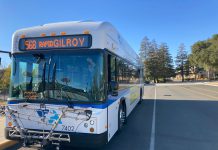The South Valley is full of avian wildlife to observe on your
jaunts
By Carolyn Straub Special to South Valley Newspapers
Next time you’re barreling down a South Valley road at 50-plus on a bike, dressed up like Lance Armstrong, stop and sniff the sage and vinegar weed.
Two California quail could scud across in front of your Trek or Schwinn. Plumes high, they’d hurry fast. As quail do, they’d probably bob and run like windup toys.
If you’re out on a trail or road, taking it a little slower can give you a good chance to see some avian wildlife. So in addition to your gloves, regulation helmet, and other accouterments, how about including a bird watcher’s guide in your pedal pack?
Maybe “The Sibley Field Guide to Birds of Western North America” or Kenn Kaufmann’s “Birds of North America.” Or “Birding at the Bottom of the Bay,” BBOB as birdwatchers dub it, available through the Santa Clara Valley Audubon Society. It’s a good regional guide to finding “peeps” in the eastern foothills of Gilroy, Morgan Hill and Hollister.
Try multitasking at the wheel: Take a bag lunch. Scout out the plants and wildlife along the road before pedaling away. Bike, stop, rest, bird a bit, snack. You get the picture.
You might try birding at the southern entrance to Coyote Creek Parkway, a well-known hiking, walking and biking path that stretches 15-and-a-half miles north, ending at Coyote Hellyer County Park in San Jose. The south trailhead begins in Morgan Hill at the end of Malaguerra Avenue just outside Anderson Lake County Park. Parking a car is free there, and it’s not unusual on a fall day during avian migrating season to spot as many as 60 bird species in a solo bike ride.
A good hour to go birding and biking is around sunrise or sunset. It may be cool at 50 or 60 degrees, so wear warm gear. White morning mist can hover over Coyote Creek Parkway early, making it mysterious. Path hours are dawn to dusk. Rule of thumb: always go with a companion. Launch quietly, so you don’t startle the birds, who’ll escape before you can put up your binoculars.
The state bird, the California quail, is often seen along this point of the parkway. For my biking partner and I, it was 6:55am one Saturday. That’s early, but not early enough to compete with real birders, the dedicated who have been known to be out at 3am to go “owling,” or listening for owls.
The hard gallop of non-birding bikers soon came our way. We trudged on, binoculars dangling above our handlebars and a birding guidebook tucked at our backs.
A belted kingfisher flew overhead near Coyote Creek. There was a sudden fuss near the creek as a Cooper’s hawk flew back and forth. We halted our bikes at our first stop and walked to the bank. There were leaf-hoppers, birds in trees who turned out to be commonly seen Steller’s jays and western scrub-jays. A wood duck fluttered in the fog above. We bumped along stopping and starting, spying a Wilson’s warbler on the bridge.
We ceased peering and zoomed about 500 feet, enjoying the ride. There was rustling in the brush and we stopped to look for feathered things. Six bikers thundered by us.
“It’s safer to bird by ear. You can hear the birds, stop and get off your bike,” commented Emelie Curtis, an avid birder and walker from Morgan Hill. “There’s always the chance for an accident when doing two things at once.”
We pedaled as far as the Model Airport, about 2 1/2 miles from our starting point, where a great egret elegantly stood at the edge of the playing field. Naturally, we grabbed the binoculars.
“I might make birding my next passion,” said Scott Gillis of Morgan Hill, a teacher at Leland High School in San Jose, who had just finished running. “I’m not a meanderer enough to bird and bike.
“Hey, what’s that one that stays in the air?” he asked. “God, it’s awesome.” We told him it was a white-tailed kite, a common small hawk that searches for prey by fluttering in one place overhead. It was nearby doing it’s thing.
“They go together quite well, birding and biking, ” said Ed Rife of Morgan Hill, who was atop his bike. He said he often carries a bird-identifying sheet. Rife and his wife, Jo Anne, were starting a ride.
“I can only imagine,” mused Russ Anderson of Sunshine Bicycles in Gilroy when asked later about the combination of birding and biking. “But I’ve only done a little bit of birding in Elkhorn Slough,” he said.
Brian Lucas, owner of Off the Chain Bikes in Hollister said he bikes regularly on the back roads of north San Benito County with a weekly group at the store. “We have an unofficial club,” he said. “I recognize birds and point them out. We don’t really seek them out. We’re appreciative of the animals out there.”
When we two go, we are the only ones birding and biking. Meeting and sharing with folks is, therefore inevitable. Passersby usually slow down and ask us, the bike and binocular-clad: “What’re you looking at? What’s out there?” The fun begins when we explain.
One last thing: be sure to bring plenty of water to drink.
Us? We just want to know who the airborne residents are when we bike out for a day.
How to Get to Birdy Circuits:
For the southern trailhead of Coyote Creek Parkway, take 101 north or south and exit at Cochrane Road and drive east toward Anderson Lake County Park. Turn left at Malaguerra Avenue in Morgan Hill. Park for free at the end of Malaguerra Avenue near the office. Bike path begins in a few feet.
An alternative is to bike the less-traveled Gilroy Hot Springs Road to Canada and Jamieson roads in Gilroy, past open fields and grasslands where there are golden eagles. Take Leavesley Road east. Turn left on to New, then right on Roop Road. Begin at the Mendoza Ranch Entrance to Coyote Lake-Harvey Bear Ranch County Park on Roop. Roop Road becomes Gilroy Hot Springs Road. Canada Road is a right turn off Gilroy Hot Springs Road.
American Birding Association’s Code of Birding Ethics: http://americanbirding.org.












